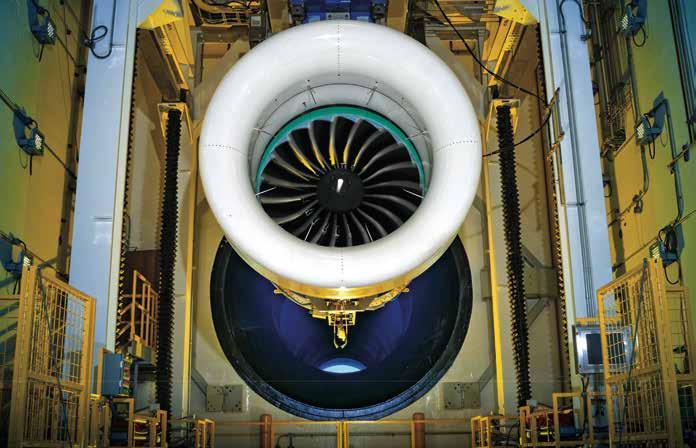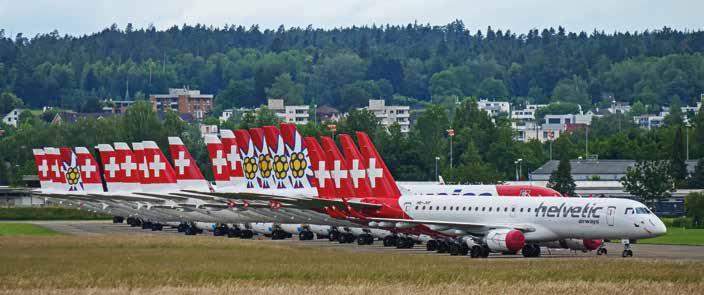
33 minute read
SAS 12
Niklas Prescher/Shutterstock MRO revenues nosedived in 2020 as many aircraft went into storage
So, what next? And what are the recovery scenarios and strategic moves likely to be seen in the sector? The most obvious impact is that for an industry that has stalled, there will be surplus capacity and some MRO players will either fail or downsize.
Advertisement
“Airlines may face some challenges in terms of disruption of supply as the supplier base in certain markets or geographies comes under strain,” believes Stewart.
AJW, which carries a hefty parts inventory worth $500 million, has dipped to 65% of its pre-pandemic revenue base, but has restructured and lent heavily on its diversified portfolio in addition to airline clients to weather the storm. “There will be a culling of people in our business that don’t have contracted services, military or cargo business,” says Whiteside.
Those that survive will be keener than ever to do whatever it takes to win. “We have been even more engaged with our customer base as a partner through the crisis – it’s all about avoiding unnecessary spending,” says Martin Friis-Petersen, senior vice-president
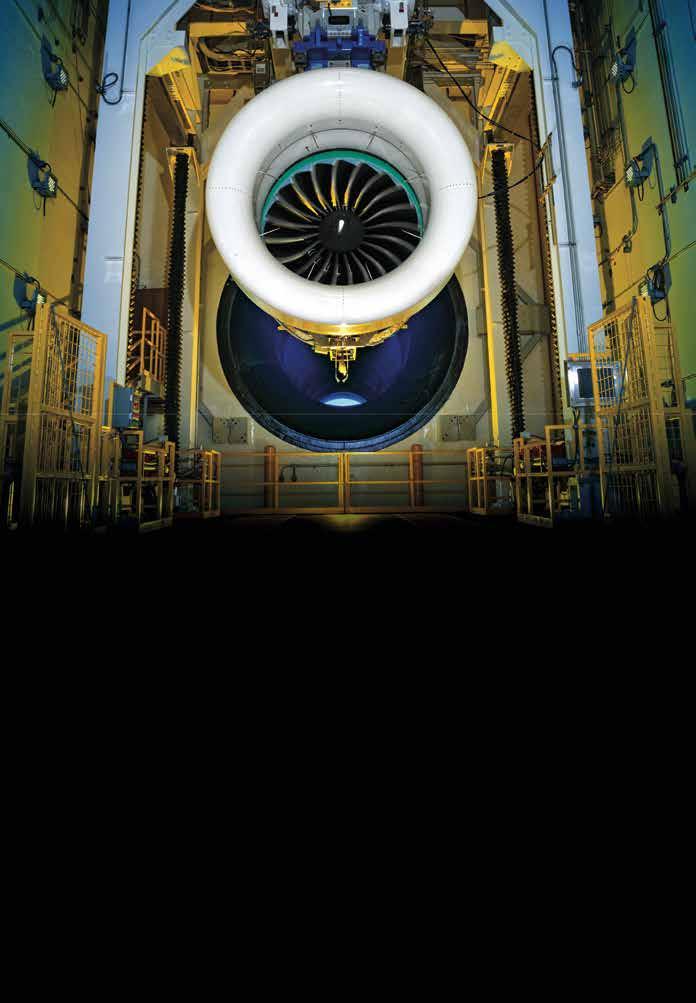
35%
Pandemic-driven fall in revenue recorded at global parts and repair specialist AJW
MRO programmes at MTU Aero Engines.
Strong, credit-worthy airlines have found suppliers willing to entertain flexible payment terms, discounts on shop visits and help to use so-called “green time” engines – powerplants with life left on the clock. Higher-risk carriers will not always be offered such flexible terms.
Airlines have been outsourcing their MRO services for years, and this trend may accelerate again. The goal is to move from high fixed costs, such as in-house MRO entities, to a more variable cost base. “Boardrooms will once again be asking the question: why do we want the infrastructure?”, says Stewart.
It may be attractive for some to look at partial disposals of their MRO assets as a mechanism to raise capital. A sale of a 30-40% stake in an airline MRO would be an attractive prospect for private equity, a sovereign wealth fund or pension fund seeking a secure income stream, while the airline retains operational control.
For Airbus and Boeing, there may be a requirement to temper aftermarket ambitions as they digest bigger issues for now.
“There is a need to refocus on the core business and return to a steady state. And there is the fact that the services business is even more competitive than ever because everyone is fighting for survival,” says Yann Cambier, aviation principal at ICF.
While the desire to capture more aftermarket business will remain, the trend could be away from capital-intensive services and to higher-margin activities such as data services, around predictive maintenance, or via acquisitions of specialist service providers.
Alternative spares
The expected increase in retirements, aircraft part-outs and availability of green engines for some years ahead has ramifications for supply and demand across the whole services ecosystem. Manufacturers of non-OEM spare parts, which airlines can favour as they are cheaper than those bought from the original manufacturer, should be well placed, as well as companies specialising in parts repair.
MTU works in some of these areas, in addition to offering used serviceable material (USM) and greentime engines, and in-house parts repair. “The wave of retirements expected from mid-2020 has not materialised, but it will come,” says Friis-Petersen. “We will be an active player where we see value.”
A disrupted industry brings opportunities, and the environment is ripe for mergers, acquisitions and consolidation. Cambier says that with excess MRO supply “ICF expects that investors may buy some suppliers with weak cash positions”.
Stewart agrees: “There are private equity investors that are looking for a good deal in a market that has long-term growth prospects.” There is plenty of interest, he says, particularly in players that deal in end-oflife services, asset management and USM.
How the aftermarket develops in the coming years is entirely dependent on the pace and shape of the traffic recovery. A snap back to previous growth patterns could see the aftermarket arena emerge battered and bruised but fundamentally unaltered.
Analysts are cautious about predicting wholesale changes just yet, but the underlying feeling is that some business models have changed for good. w
The great engine race
For aviation to achieve zero or near-zero carbon emissions in the coming decades, an entirely new suite of propulsion technologies is critical. The big manufacturers say they are up to the challenge

Airbus Liquid hydrogen fuel requires a blended wing body design such as Airbus concept

Mark Pilling London
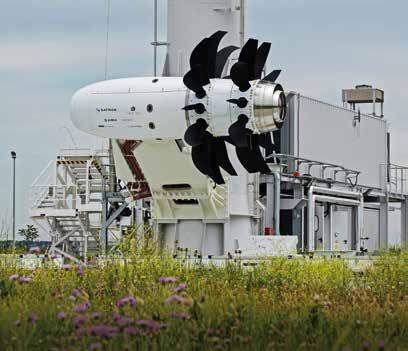
The cocktail of possible engine technologies and fuels that are going to propel an industry desperate to prove it can decarbonise becomes more extraordinary by the day.
The ingredients in this cocktail are bewildering, encompassing next-generation turbines, sustainable and hydrogen aviation fuels, hybrid, electric, fuel cells, and an intoxicating mixture of all of them.
For the engine makers researching a raft of technical solutions, a discipline that constantly absorbs millions of dollars, this is their day job. However, the task of developing the next generation of engines has arrived at the worst moment financially, with balance sheets swamped by the pandemic-induced crisis.
Nobody, however, has been tempted to take a hatchet to research and development budgets. Andy Geer, chief engineer, UltraFan at Rolls-Royce, acknowledges the challenge: “Our R&D strategy is very much unchanged by the events of the last 12 months; the only thing that has changed is the need for it to be delivered in perhaps the most cost-constrained environment that can be imagined.”
Perversely, the crisis could offer industry more clarity on its priorities. Government bailouts and stimulus packages are inexorably connected with accelerating environmental progress: what some dub the “green recovery”.
The manufacturers are aligning themselves accordingly. “Essentially the engine game has not changed, R-R’s UltraFan should be in service around 2030
but it is the speed with which these technologies are going to be adopted because the industry has really changed,” believes Arjan Hegeman, general manager of advanced technologies at GE Aviation.
“In the past 12 months, our strategy has not changed, but rather has been confirmed by the ongoing public discussions, which are driving us to continue to intensively pursue our goals,” says Stefan Weber, senior vice-president, engineering and technology for MTU Aero Engines.
Central to these goals is the all-consuming and unaltered drive for better performance. In the old days, the target was obvious: a better turbofan than the previous generation, bringing double-digit fuel burn efficiency gains for airliners to bring lower costs.
And they are good at it. For example, CFM International brought in a 20% improvement with the CFM56, while its successor, the Leap, has delivered another 15%, explains Jerome Bonini, vice-president research and technologies at Safran Aircraft Engines.
But when will the next step-change be required? Guillaume Faury, Airbus chief executive, offered clarity in March during a Eurocontrol webinar, saying that a 2035 entry-into-service date for a next-generation aircraft “makes sense”. A formal launch would take place in 2027-2028, giving industry a lead time of five to seven years to mature the technology, he said. Faury has also been enthusiastic that a future jet will feature hydrogen fuel in some form. Airbus is pushing hydrogen because it offers the most significant impact on carbon emissions reduction.
So, what will the next-generation engine be? Hydrogen is firmly in the sights of all manufacturers; but whether the fuel is Jet A-1, sustainable aviation fuel (SAF) or hydrogen, the turbine engine is the starting point in each case.
“What is obvious is that, for the foreseeable future, there will be no alternative to the aero gas-turbine – in further optimised form – as a propulsion system for large commercial aircraft,” says Weber.
“We have spent $10 billion on a technology that was moving in a direction we knew we had to go,” says Geoff Hunt, senior vice-president engineering and technology at Pratt & Whitney, describing the US manufacturer’s bet on its geared turbofan (GTF). “We have established what I think is a benchmark architecture that provides the flexibility to adjust as the industry looks towards climate change alignment.”
As a matter of course, P&W expects to be able to continue the trend of annual fuel efficiency improvements of 1% on average as programmes mature. “Continuing to improve on the GTF architecture is very much the near-term drive and that is consistent with the long-term strategy if you are going into SAF or hydrogen fuel or hybrid-electric,” says Hunt. The
introduction of these fuels and technologies “will all base off that architecture”, he adds. “The first pillar of our strategy is to define and build an ultra-efficient engine architecture,” says Bonini. Safran is working on different architectures – for example, the work it has conducted into open rotor design, in preparation for the aircraft configuration the airframers will chose. Like P&W with the GTF, CFM joint venture partners GE and Safran have a modern-generation engine, in their case the Leap, as a baseline propulsive system architecture. Alongside this work there is heavy investment in lightweight, high-performance materials as well as sophisticated cooling technologies, as the trend towards higher engine pressures and temperatures continues. “All these new technologies will work their way into the engine,” says Hegeman. The conviction that a next-generation turbine is an essential pillar for “decarbonising aviation” is the reason R-R remains committed to its UltraFan programme, says Geer. “We plan to have that engine available around the turn of the decade and as it is a scaleable technology, it is suitable for both narrowbody and widebody new aircraft programmes,” he adds. For its part, “MTU is currently concentrating on the WET [Water-Enhanced Turbofan] engine,” says Weber. This employs a heat exchanger to use the energy from the engine’s exhaust gas stream to generate additional power.
Efficiency drive
Whatever mix of architecture, materials or fuel is in the cocktail, the engine technologists interviewed by FlightGlobal all agree the target in efficiency terms for the next-generation engine is 20% and more. “This generation needs to provide a major step change in efficiency to, firstly, reduce emissions by simply burning less fuel and, secondly, to enable alternative fuels spanning from SAF to electric to hydrogen by providing longer range through its increased efficiency and, as such, overcoming some of the disadvantages of alternative fuels in supply constraints and/or associated weight increases [batteries] or airframe drag increases from large storage needs [hydrogen],” Hegeman says. The use of liquid hydrogen fuel, for example, will require an aircraft shape and size like the Airbus ZEROe blended wing body design, because hydrogen takes up about four times the volume of jet fuel. Another clear strategic pillar to achieve decarbonisation is to develop engines that run 100% on low-carbon fuels, such as SAF and synthetic fuels, or liquid hydrogen, which would be zero-carbon, says Bonini.Rolls-Royce Boeing agrees. It has set a target of 2030 for all its commercial aircraft to be certified to fly on 100% SAF. Today, the maximum is a 50:50 Jet A-1/SAF mix. There is work on fuel standards and the technical
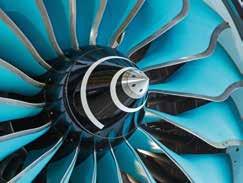
One of Safran’s projects is an open rotor design
Eric Drouin/Safran
Stefan Weber Senior vice-president, engineering and technology, MTU Aero Engines
MTU Aero Engines Focus at MTU is still on performance, says Weber
changes needed to run turbines at 100% SAF, but it is not a tough nut to crack and 2030 or probably earlier is achievable.
The prospect of burning liquid hydrogen in aero engines is more captivating. The first thing the engine makers point out is that hydrogen is not new to them. P&W ran a hydrogen engine in the 1950s, while GE ran one in the 1960s. Russian scientists flew a modified Tupolev Tu-154 using hydrogen fuel in the late 1980s.
“We understand the challenges and the opportunities of hydrogen. From an engine manufacturer’s perspective, we do not see we are the long pole in the tent to get into a hydrogen solution at the aircraft level,” says Hunt.
“Burning hydrogen inside an engine is not the issue; getting the hydrogen into the right conditions to be used is the challenge,” explains Bonini. In February, Safran announced the Hyperion study, where it will work with space launch vehicle maker Ariane Group and Airbus on turbines that burn liquid hydrogen.
Yes, the combustor will be different, as is the control system – but the biggest challenge is not how the fuel is burnt, it is upstream and integrating it into the aircraft design, says Hegeman.
Questions on storing the bulky hydrogen in the airframe and the infrastructure needed to deliver it to an aircraft are harder to answer. “The bigger challenge, similar to SAF, is the need to scale it up. And the need will be for green hydrogen,” explains Hegeman, referring to hydrogen produced using renewable power generation.
The view is that liquid hydrogen will be an attractive longer-term option, with advances in current turbine technology and the use of SAF both providing near-term benefits.
“An ultra-efficient engine is still the key to the future – whatever fuel you burn,” says Bonini. Embedding electrical systems in such engines to create a hybrid configuration will deliver further levels of efficiency and represents the third strategic pillar of decarbonisation.
The target is to make hybrid variants of current models, such as P&W’s GTF family and CFM’s Leap, where electrical power is generated to help provide or save energy in the engine. The aim of this work, says Weber, is “the most complete electrification of the drive train possible in order to be as emission-free as possible in flight”.
Many believe the concerted hybrid research efforts in play will yield benefits in the short- to mid-term. “A hybrid-electric variant of GTF is certainly something that we are studying,” says Hunt. Although P&W did last year slow Project 804, an effort to develop a hybrid-electric engine for a regional aircraft, starting with a De Havilland Canada Dash 8-100, this work has a “lot of merit” and is ongoing, he says. However, a flight demonstration planned for 2022 will slip.
At P&W, there is a benefit having sister Raytheon Technologies company Collins Aerospace in the family. “We work extremely closely with Collins, which has very strong capability in the electrical systems area,” says Hunt.
GE has been working on a basket of hybrid research efforts for more than a decade, including a project in 2016 where 1MW of electrical power was siphoned off from a military F110 engine while also generating thrust. This much electrical energy could power a small, six- to 10-seat aircraft.
The years of foundational work spent on such research gives GE confidence it will have the answers. “We are running all of these systems towards a flight of a full hybrid propulsion system,” says Hegeman. “We are very far along that journey, with a ground demonstration of a fully built-up engine and flight demonstration of a twin aircraft planned within a couple of years.” The hybrid technologies under development will have applications in turbines powering jetliners in the 100-plus seat class, and there are dozens of smaller aircraft being touted for cargo, regional airline, and urban air mobility opportunities. Further down the size class there are many working on all-electric engine applications. Another technology with promise, which MTU advocates for the longer term, is the conversion of hydrogen into electricity with the help of fuel cells. It is studying this technology with the DLR German Aerospace Center. “These technologies could go into series production even before 2040,” believes Weber.
Ultimately, all the engine makers say they will respond with a powerplant when asked. “There isn’t any user knocking on our door today. When they do, we are going to have a product,” says Hegeman.
Today, the product opportunities appear to centre on a new narrowbody to succeed the Airbus A320 and Boeing 737 Max families, while Boeing chief executive David Calhoun has hinted that it might still develop an aircraft with around 270 seats.
Airbus has been the most progressive and aggressive, clearly signalling a desire to speed up moves to low or zero-emissions aircraft, while Boeing has committed to its 2030 target for using 100% SAF on all its commercial aircraft.
With their existing positions on the A320 and 737, CFM and P&W appear well placed, while R-R is relying on its UltraFan to force its way into the reckoning. “This is a new generation of gas turbine, with the capability to grow and adapt to become an entire engine family, designed for service around the turn of the decade, offering a 25% efficiency improvement compared with our first generation of Trent engine,” says Geer.
Multiple technologies
As Bonini explains, a new class of low-carbon engine will bring millions of dollars and years of research to fruition: “This is a great challenge, a huge effort, which is why we need the construction of other technologies, including SAF, hydrogen and hybridisation, to achieve the decarbonisation goals we have.”
Hegeman agrees. “I don’t think there is one single solution that is going to work. All these different technologies are going to be necessary across the whole spectrum of commercial aircraft,” he says.
With its open rotor technology, Safran claims it has already demonstrated a 15% fuel efficiency gain compared with the Leap. Moving away from a nacelle, as an open rotor does, is one of the options airframers will be considering as they deliberate aircraft configurations.
Perhaps an open rotor design is one of the answers. Perhaps not. Today, it is impossible to judge which technologies, in which order, or in what blend, will flourish. The manufacturers are obliged to spend big across a variety of bets, uncertain as ever if their strategy will be the one that ultimately succeeds.
The flag has truly dropped on this urgent technology race to discover a new low- or zero-carbon aviation engine nirvana. Without doubt, it is a contest the engine manufacturers are relishing. Their tradition says they almost always come up with the answer. They are convinced they will this time too. w

Jerome Bonini Vice-president research and technologies, Safran Aircraft Engines

Why Honeywell is an eager disruptor
To help describe where it plays in the hybrid engine space, Honeywell has a nifty slide with nine boxes on it that explains the thrust source (turbine, electric, or both) and power source (fuel, battery, or both).
The important part for the US aerospace manufacturing giant is that it can tailor a solution in seven of the nine hybrid architectures to address product opportunities in civil and defence markets, from commercial airliner auxiliary power units (APUs) to helicopter engines and in unmanned air vehicles (UAVs).
“It’s our view we need to be prepared for conventional and disruptive solutions,” says David Marinick, president of engine and power systems at Honeywell. “We are working on improvements to conventional architecture, such as greater efficiency and better fuel burn for our APUs, including the ability of our turbomachinery to run on sustainable aviation fuels [SAFs].”
But with every passing quarter, “more of our investment is moving toward the disruptive side”, says Marinick. A growing element of this disruption is the development of electric, hybrid-electric and hydrogen propulsion technology.
This is familiar territory for Honeywell, says Marinick, for “integrating gas turbines with generators and gearboxes is something we have been doing for decades. We feel we are in our core here.”
The next step on its roadmap is a recently announced plan to mate a 1MW Honeywell generator with its HGT1700 APU, which is found on Airbus A350s, to create a turbogenerator. A demonstration unit will run this year with a view to a product that could power air taxis, cargo UAVs and small hybrid-electric aircraft.
“We feel like in many ways we are uniquely suited in this space, because we have so much domain expertise,” says Marinick. Part of its DNA is being a partner with the engine OEMs on a host of airframes, and the “opportunity for [further] partnerships is strong”, he believes.
There will undoubtedly be new players to this market that will take on the established order, but Marinick is unfazed. “The combination of both might ultimately win the day with the best of both worlds,” he says.
“We maintain a very strong interest in hydrogen, both as a fuel cell and as a fuel source,” he adds.
Honeywell brought some “compelling technology” into the company last October, with the acquisition of US hydrogen fuel cell system firm Ballard Unmanned Systems, which manufactures engines for UAV applications.
Honeywell is designing powerplants for air taxis, cargo UAVs and hybrid-electric aircraft
Safran
Low-carbon engines represent years of research, says Bonini
GE Aviation
GE has invested heavily in future powerplant research
While Covid-19 meant it was anything but business as usual for aircraft orders from airlines, a number of powerplant decisions, contracts and aftermarket developments were still finalised over the past year
Engine tracking
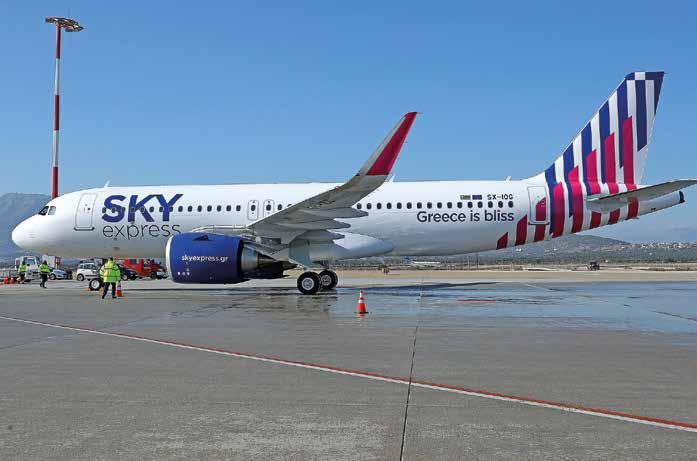
Editor’s Note: The below is a selection of the powerplant decisions, support agreements and engine aftermarket developments across the past 12 months covered by FlightGlobal, with additional reporting from Cirium
October 2020 January 2021
Sky Express picks Leap for its Neos Frontier diversifies with P&W engines
Greek carrier Sky Express selected CFM International Leap-1A engines to power the four Airbus A320neos it began taking delivery of in November.
CFM valued the engine order at $130 million at list prices.
The airline will also lease two additional Leappowered A320neos.
SkyExpress owner Ioannis Grylos says: “We chose the Leap engine based on CFM’s long-standing experience in powering single-aisle aircraft. The reliability of CFM engines, combined with the Leap fuel efficiency and environmental performance, will be key assets to supporting the sustainable growth of our company.” ◗ US carrier Frontier Airlines has selected Pratt & Whitney PW1100Gs to power 134 incoming Airbus A320neo-family jets, a move that will diversify its fleet away from complete reliance on CFM International powerplants.
The Denver-based ultra-discount airline, owned by private equity company Indigo Partners, currently operates jets powered only by CFM’s Leap-1A and CFM56 engines. Airbus offers A320neo-family jets with a choice of Leap-1As or P&W’s PW1100G geared turbofan.
“The airline is a first-time Pratt & Whitney customer and will operate their GTF-powered A320neo-family aircraft on domestic and international routes in North
Sun Express Greek start-up opted for Leap engines for its planned fleet of six A320neos
America,” P&W said on 25 January.
The 134 jets that will receive PW1100Gs include 49 A320neos, 67 A321neos and 18 A321XLRs, P&W says. The first of those aircraft is due for delivery to Frontier in 2022. P&W will also maintain those engines through a long-term service contract, the Connecticut-based engine maker adds. Frontier has a total of 156 A320neo-family jets on order. It has not disclosed which engines will power the other 22 jets, according to Cirium fleets data.
Other aircraft in the fleet of all-Airbus operator Frontier include 14 first-generation A320ceos and 17 A321ceos, all powered by CFM56s. ◗
Scandinavian operator SAS has stayed with CFM International for a further batch of engines for its Airbus A320neo-family fleet.
SAS has directly ordered a total of 65 A320neos of which 30 have been delivered so far. It also operates another 15 on lease, including a single A321LR, all of them fitted with the CFM Leap-1A powerplant.
CFM says SAS has again selected the manufacturer for the additional 35 aircraft it ordered in April 2018, topping up its original agreement for 30 placed in June 2011.
The deal covers 78 engines – 70 for the 35 twinjets plus eight spares. It also features a per-hour maintenance agreement bringing the overall list-price value of the order to $2.9 billion.
“We take SAS’s trust as a great responsibility to keep supporting their operations with the high-level CFM standards in terms of reliability and utilisation,” says CFM chief Gael Meheust.
SAS says the maintenance pact includes spares and also covers the 15 Leap-powered aircraft it has on lease. “This new agreement is part of SAS’s fleet upgrade programme that aims to improve efficiency and sustainability performances,” it adds. ◗
Mexican discount airline Volaris has agreed to power another 80 incoming Airbus A320neo-family jets with Pratt & Whitney PW1100G geared turbofans.
The Hartford-based engine maker confirmed on 11
February that it had signed an agreement with the airline to supply the engines.
P&W competes for A320neo engine sales with CFM
International, which offers its Leap 1-A as a power option for the jet.
Volaris has long stuck with engines made by P&W and its affiliate International Aero Engines.
The airline’s 84 in-service jets include 54 firstgeneration A320s powered by IAE V2500s, and 30
PW1100G-powered A320neo-family jets, Cirium fleets data shows.
February 2021
SAS keeps with Leap on A320neo Volaris adds to P&W commitment
US low-cost carrier has concluded a long-term service agreement covering 230 International Aero Engines V2500s on its A320ceos
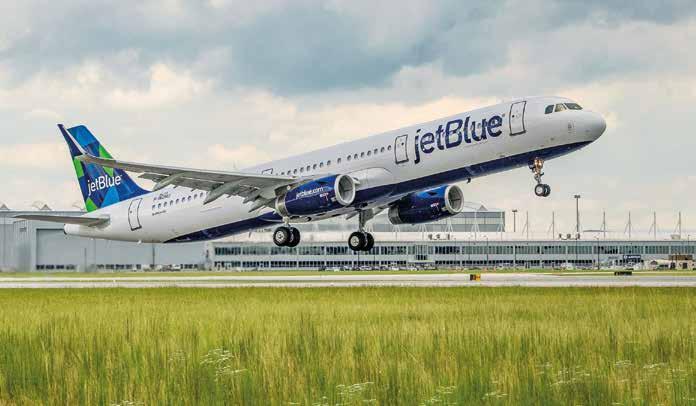
Airbus
❱ Volaris has 43 A321neo aircraft and 56 A320neos on order with Airbus.
With the latest deal, Volaris has committed to receiving a total 124 PW1100G-powered Airbus narrowbodies.
Volaris has also signed a long-term agreement under which P&W will maintain the powerplants. ◗ March 2021
Southwest Max order boosts CFM
Air France finalises GTF deal on A220s
Air France-KLM Group in February finalised an order for more than 120 Pratt & Whitney GTF engines to power 60 Airbus A220-300s.
The GTF engine is the sole powerplant option available on the A220, an order for which Air France-KLM first unveiled in the summer of 2019.
Deliveries of the aircraft, which will be operated by Air France, are due to commence in September.
The engines will be supported by Pratt & Whitney through a long-term comprehensive service agreement, with engine maintenance planned to be carried out by AFI KLM Engineering & Maintenance. ◗ Southwest Airlines signed a contract with CFM International for Leap-1B engines to power another 100 Boeing 737 Max aircraft after its follow-up commitment for the type announced at the end of March.
The US carrier was launch customer for the engine, the sole powerplant option available on the Boeing Max aircraft. Southwest, the biggest Max customer, placed a follow-on order for 100 Max 7 aircraft on 29 March. ◗
May 2021
IndiGo picks CFM to power new jets
Indian budget carrier IndiGo has chosen the CFM International Leap-1A for another 310 Airbus A320neo-family aircraft.
It operates A320neos and A321neos with the Leap1A and rival Pratt & Whitney PW1100G powerplant.
But the selection of 620 new engines – plus spares – cements CFM as the primary supplier to airline’s re-engined fleet. The Leap-1A will be used on aircraft including IndiGo’s new long-range A321XLRs. ◗ June 2020
P&W adds Maine MRO capabilities
Pratt & Whitney will be expanding its North Berwick, Maine, facility to include MRO capabilities for the PW1100G geared turbofan.
The expansion is part of a $12.5 million investment the engine maker is pumping into the plant. P&W adds that the investment “bolsters” its global PW1100G MRO network and “accelerates growth by utilising the facility’s existing expertise”.
The North Berwick plant, which employs more than 2,000 people, manufactures components and parts for commercial and military engines.
While P&W has not gone into detail over what the expansion will entail, it says: “The transformation will consist of upgrades to the current space, increasing efficiencies to help minimise disruption to the current flow of operations and allowing for a seamless transition as the facility takes on a new role.” ◗
July 2020
JetBlue inks deal to support V2500
JetBlue Airways signed a 13-year fixed-price support agreement with International Aero Engines covering 230 V2500 engines that power the airline’s A320ceo family fleet.
Chief financial officer at the US carrier, Steve Priest, says: “The V2500 engine has been the workhorse of the JetBlue fleet since the airline’s inception. “This agreement provides predictable maintenance and supports efficient operations needed to serve our customers for many years to come.” ◗
September 2020
LHT to open up Dublin repair shop Ameco in China first for PW1100G
Lufthansa Technik (LHT) will open an engine repair station in Dublin in early October to meet increased demand for limited repairs that keep engines flying.
The new facility is part of the MRO provider’s mobile engine services network, and will be used to conduct repairs on site or at customer facilities.
“These solutions extend an engine’s time-on-wing and… enable airlines to postpone or even avoid cash-intensive major overhaul shop visits,” the company says.
Dublin will be the fifth engine repair station in the network. Existing facilities are located in Frankfurt, Montreal in Canada, Tulsa in the USA, and the Chinese city of Shenzhen.
The new site in the Irish capital – close to the aircraft leasing community, LHT notes – has five repair bays and will employ more than 20 mechanics. It will initially support CFM International CFM56-5B and -7B engines, which power Airbus A320ceos and Boeing 737NGs, respectively. ◗
Pratt & Whitney has opened its first PW1100G geared turbofan MRO centre in China, by adding Beijing-based Ameco to its global network of MRO providers.
Ameco will also be Asia’s fourth PW1100G MRO centre, after Eagle Services Asia in Singapore, as well as IHI and Mitsubishi Heavy Industries Aero
Engines in Japan.
P&W adds that by the end of the year, there will be 10 active PW1100G MRO centres in the world, including Ameco.
Chinese Operators of the type include Ameco parent company Air China, as well as China Southern Airlines and Sichuan Airlines. ◗
November 2020
CFM wins Chinese carrier MRO work
CFM International has inked long-term contracts with China Eastern Airlines and Zhejiang Loong Air for the maintenance of Leap1A engines on their Airbus A320neo aircraft.
The engine maker signed a 12-year, rate-per-flighthour agreement with both carriers, which will see it base maintenance costs on a per-engine flight-hour basis. Both carriers also placed orders for spare Leap1A engines, one of the two powerplant options for the A320neo family.
With China Eastern, the contract covers 36 A320neo aircraft, which are operated by the China Eastern Group of carriers. China Eastern also ordered six spare Leap-1As.
CFM also says the contract adds to a 2017 agreement signed between both parties, when China Eastern picked CFM to power its A320neo fleet.
As for Loong Air, CFM will provide maintenance for Leap engines on its leased fleet of A320neo family aircraft. ◗
OGMA takes on PW1100G support Air Serbia selects MTU for V2500s
Air Arabia signs CFM support deal
Embraer’s Portuguese maintenance affiliate, OGMA, has become an authorised Pratt & Whitney PW1100G maintainer, a move Embraer says reflects its push towards revenue diversification.
OGMA is now part of P&W’s “authorised maintenance centre network”, giving P&W its first MRO presence in Portugal, says Embraer.
Notably, OGMA will service PW1100Gs – the geared turbofan that powers Airbus A320neo-family aircraft. Embraer services and support chief executive Johann Bordais tells FlightGlobal the work will help Embraer’s service business increase revenue by being more “agnostic”.
“It is very big milestone in our strategy to remain one of the centres of excellence in engine maintenance in the world,” he adds.
Bordais expects that OGMA will expand in future years to maintain other GTF variants, such as the
PW1700Gs and PW1900Gs that power E-Jets E2s. ◗ MTU Aero Engines has won a contract to maintain International Aero Engines V2500s powering Air Serbia’s Airbus A320-family fleet.
The exclusive, six-year deal spans MRO services, trend monitoring and spare engines, MTU says.
Air Serbia’s fleet comprises 21 aircraft. The airline’s website indicates that the fleet includes 11 A319s and one A320. These are operated alongside an A330 and ATR 72 turboprops at the mainline, and Boeing 737 Classics at charter subsidiary Aviolet. ◗
UAE carrier Air Arabia has signed a nine-year agreement with CFM International under which it will support the airline’s fleet of six Leap-1A-powered A321neo aircraft.
The agreement builds on a relationship with CFM that includes a fleet of 52 CFM56-powered A320ceo aircraft and six A321neo-LRs.
Air Arabia, which signed for 120 A320neo aircraft at the Dubai air show in November 2019, is the first Leap-powered A321neo operator in the Middle East. ◗
2,200
Number of shop visits overseen by SR Technics covering the CFM International Leap-1B engine
Uganda Airlines took delivery of its first A330neo, powered by the Rolls-Royce Trent 7000, in December 2020
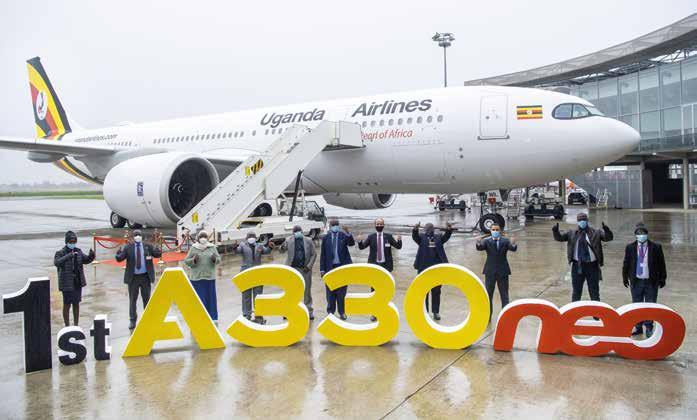
Airbus December 2020
P&W grows GTF network in Asia
Uganda Airlines chief executive Cornwell Muleya says: “We are proud to include our new Rolls-Royce powered Airbus A330neos into our fleet and this agreement will ensure that our Trent 7000 engines will be maintained to world-leading levels of service.” ◗
April 2021
Pratt & Whitney in December expanded its PW1100G geared turbofan MRO centre in Asia, adding new providers in China and Taiwan.
On 3 December the company announced that MTU Maintenance Zhuhai – a joint venture between China Southern Airlines and German engine specialist MTU Aero Engines – would join the network of MRO providers. It becomes the second PW1100G
MRO centre in mainland China alongside Ameco.
P&W then in mid-December announced that China Airlines, through its MRO division, would provide engine MRO for the P1100G at its facility in Taiwan. ◗
January 2021
MTU adds P&W shop in Zhuhai
MTU Aero Engines is building a second overhaul facility near its MRO joint venture with China Southern Airlines’ parent in Zhuhai, which will be dedicated to servicing Pratt &
Whitney PW1000G engines.
Scheduled to become operational in 2024, the new site – to be named MTU Maintenance Zhuhai Jinwan branch – will have an “initial” capacity to handle 250 engines per year and employ around 600 staff “according to current estimates”, MTU says.
It will have its own test cell and “focus on Pratt & Whitney narrowbody engines”, the Munichheadquartered company says, without disclosing precise models. ◗
February 2021
Uganda Airlines seals Neo support
Uganda Airlines has signed a TotalCare agreement with Rolls-Royce covering its two new Trent 7000-powered Airbus A330neos.
The Ugandan carrier took delivery of its first A330neo, which is exclusively powered by the R-R engine, in December 2020 and the second in January 2021.
Rolls-Royce seals DHL Trent pact
DHL Express has concluded an aftermarket service agreement with Rolls-Royce for Airbus A330-powering Trent 700 engines.
R-R says the hour-based contract covers eight Trent-powered A330 freighters currently in operation at DHL and any Trent 700 engines that will be added to the operator’s fleet in future.
DHL operates purpose-built A330-200Fs and converted A330 freighters, the engine maker notes.
In 2017, DHL became the first A330 passenger-to-freighter (P2F) operator, with an A330-300 converted at Elbe Flugzeugwerke in Germany. But that aircraft is powered by Pratt & Whitney PW4000 engines. ◗
May 2021
SR Technics adds Leap-1B service
Maintenance firm SR Technics is to extend its servicing portfolio to cover the CFM Leap-1B engine for the Boeing 737 Max.
The company says it is aiming to achieve certification approval for work on the powerplant at its Zurich facility by the first quarter of next year.
SR Technics already carries out maintenance on the
CFM56, which powers earlier 737 variants as well as the Airbus A320 family.
It states that it has overseen more than 2,200 shop visits with this powerplant.
As a result of an agreement with the engine manufacturer – a venture between Safran and GE Aviation – at the end of 2020, it is to broaden its remit to the
Leap-1B.
“[We are] confident [we] can establish initial capabilities on the Leap-1B in less than a year,” states SR
Technics.
Vice-president of new engines Florent Leforestier says the measure is a “natural and essentially necessary move forward” for the company.
SR Technics already provides line maintenance for the 737 Max. CFM International chief Gael Meheust says the extension will continue the manufacturer’s
“long-standing relationship” with the servicing firm. ◗
Engine options by commercial aircraft
Aircraft type No of engines Engine option 1 Engine option 2 Engine option 3
2 PW1000G
2 CF6 PW4000 JT9D
A310* 2 CF6 PW4000 JT9D
A318
2 CFM56-5B PW6000 A319/A320/A321 2 CFM56-5B V2500 A319neo/A320neo/ A321neo 2 Leap PW1100G A330 2 CF6 PW4000 Trent 700
A330neo 2 Trent 7000 A340-200/300* 4 CFM56-5B A340-500/600* 4 Trent 500 A350 2 Trent XWB
4 GP7200 Trent 900
2 D-36
2 D-36
4 D-18
2 D-436
2 D-436
6 D-18
4 ALF502 LF507
4 LF507
717* 2 BR700
727* 3 JT8D Tay
737-200*
2 JT8D 737-300/400/500* 2 CFM56-3B 737NG (-600/700/800/900)* 2 CFM56-7B 737 Max (-7/8/9) 2 Leap 747-100/SP* 4 JT9D RB211 747-200/300* 4 CF6 JT9D RB211 747-400* 4 CF6 PW4000 RB211
747-8 4 GEnx-2B
757* 2 RB211 PW2000 767-200/300* 2 CF6 PW4000 JT9D 767-200ER/400ER* 2 CF6 PW4000 767-300ER/300F 2 CF6 PW4000 RB211 777-200/200ER/300 2 GE90 PW4000 Trent 800 777-200LR/300ER/F 2 GE90 777-8X/9X 2 GE9X 787 Dreamliner 2 GEnx-1B Trent 1000
DC-8* 4 JT3D JT4A
DC-9* 2 JT8D
DC-10* 3 CF6 JT9D
MD-11* 3 CF6 PW4000
Aircraft type No of engines Engine option 1 Engine option 2 Engine option 3
MD-80*
MD-90*
Bombardier 2 JT8D
2 V2500
CRJ (all variants) 2 CF34-8
COMAC
C919
ARJ21
Embraer 2 Leap-1C CJ-1000AX 2 CF34-10
E-170/175/190/195 2 CF34 ERJ 145 family 2 AE 3007 E-Jet E2 family 2 PW1700G/PW1900G
Fairchild Dornier
328JET*
Fokker 2 PW300
F28* 2 Spey Fokker 70/100* 2 Tay
Ilyushin
Il-62*
Il-76*
II-96*
Il-114-300
Irkut 4 D-30
4 D-30 PS-90
4 PS -90 PW2000
2 TV7-117ST-01
MC-21
Lockheed 2 PW1400G PD-14
L-1011*
Mitsubishi
MRJ70/90
Sukhoi 3 RB211
2 PW1200G
Superjet 100
Tupolev
Tu-134*
Tu-154*
Tu-204
Yakovlev 2 SaM146
2 D-30
3 D-30 NK-8
2 PS-90 RB211
Yak-40* 3 AI-25
Yak-42* 3 D-36
Note: Aircraft listed are narrowbody, widebody and regional jets currently in service and/or in development, in a commercial role *Aircraft no longer in production
Commercial aircraft by engine type
Engine type Aircraft type
Aviadvigatel
D-30 Il-62*, Il-76*, Tu-134*, Tu-154*
PS-90 Il-76*, Il-96*, Tu-204
PD-14 MC-21
CFM International
CFM56 A320 family, A340*, 737 family*, DC-8*
Leap A320neo family, 737 Max, C919
Engine Alliance
GP7200 A380
GE Aviation
CF6 A300*, A310*, A330, 747, 767, DC-10*, MD-11*
CF34 ARJ21, CRJ, E-Jet
GE90 777
GEnx 747-8, 787
GE9X 777-8X/9X
Honeywell
ALF502 BAe 146*
LF507 Avro RJ*, BAe 146*
International Aero Engines
V2500 A319, A320, A321, MD-90*
Ivchenko Progress
NK-8 Tu-154*
AI-25 Yak-40*
D-36 An-72, An-74, Yak-42*
D-18 An-124, An-225*
D-436 An-148, An-158
Klimov
TV7-117ST-01 Il-114-300
Engine type Aircraft type
PowerJet
SaM146 Superjet 100
Pratt & Whitney
JT3D DC-8*
JT8D
JT9D 727*, 737-100/200*, DC-9*, MD-80*
A310*, 747, 767
PW2000 757*
PW4000 A300*, A310*, A330, 747, 767, 777, MD-11*
PW6000 A318
PW1000G A220, A320neo family, MRJ, MC-21, E-Jet E2
Pratt & Whitney Canada
PW300 328JET*
Rolls-Royce
Spey
RB211
Tay F28*
747, 757*, 767, Tu-204
Fokker 70/100*
BR700 717*
Trent 500 A340*
Trent 700/7000 A330, A330neo
Trent 800 Boeing 777
Trent 900 A380
Trent 1000 Boeing 787
Trent XWB A350
AE3007 ERJ-145 family
Note: Aircraft listed are narrowbody, widebody and regional jets currently in service and/or in development, in a commercial role *Aircraft no longer in production
SUSTAINABILITY A CLEAR AMBITION

Sustainability is at the heart of our business. From the beginning, we have invested in technologies to make our engines cleaner, quieter and more efficient. Our clear ambition is to push the limits of innovation, demonstrating uncompromising technologies that will help pave the way for an ever more sustainable future. A common mission, extraordinary together.
cfmaeroengines.com
CFM International is a 50/50 joint company between GE and Safran Aircraft Engines


